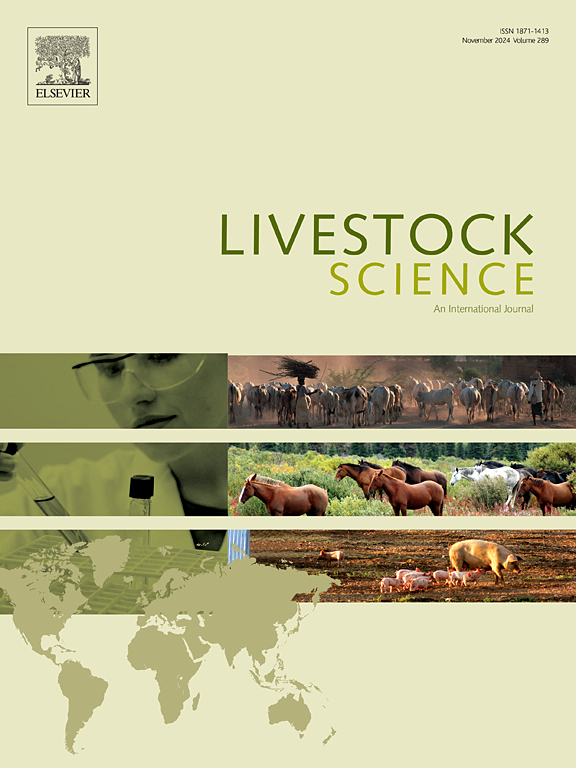畜棚排放、饲养条件和遗传对奶牛特异性地地性皮炎诊断的影响
IF 1.8
3区 农林科学
Q2 AGRICULTURE, DAIRY & ANIMAL SCIENCE
引用次数: 0
摘要
本研究的目的是应用结构方程模型(SEM),推测饲养在堆肥层状包装栏(CBPB)和传统隔间栏(CCB)中奶牛爪状紊乱性地黄性皮炎(DD)特定阶段的笼舍系统、奶牛表型和基因组学的影响。在11个猪场中,有6个猪场代表CBPB系统,2个猪场代表CCB系统,3个猪场代表混合养殖系统,其中A亚群为CBPB, b亚群为CCB。在这11个猪场中,1,047头荷斯坦-弗里西亚和弗莱科维-西蒙特奶牛(1,611个观察值)被表型为DD病、DD急性和DD慢性阶段。另外4个农场的奶牛在没有饲养和温室气体排放数据的情况下被考虑进行DD表型分型和SNP基因分型,这意味着来自1710头奶牛的2980个DD观察结果可用于DD性状的基因组研究。第一步,应用广义线性混合模型确定DD病、DD急性和DD慢性最相关的住房特征。CBPB感染概率的最小二乘均值通常小于CCB。在CBPB中,堆肥、谷仓空气和谷仓排放特性,层理温度在<范围内;28℃,层理材料中C:N比>;21、床上材料中的ph值>;8.8、小NH3浓度(<;畜棚空气湿度(0.55)、小湿度和中等湿度与DD健康状况最高相关。基于牛ARS1.2基因组序列的基因注释,单步GWAS显示了相似的DD病型和DD急性型的曼哈顿图,以及各自共享的潜在候选基因。三个相同的snp与DD急性期和DD病态期显著相关(根据标准显著性阈值),但在这方面未发现其他DD分期的重叠。根据严格的pBF,在曼哈顿图中发现了慢性DD的强关联信号,包括另外三个SNP,而急性DD的强关联信号包括位于bta23的SNP Hapmap47993-BTA-56668 (HAP)。这些snp以及奶牛DD个体的潜在变量(DD个体,包括DD阶段的表型和估计育种值),DD诊断前后的奶牛生产力,以及相关的畜舍和住房特征(通过混合模型应用确定),在DD病、DD急性和DD慢性的SEM中同时考虑。住房和畜棚的特征在DD病和DD急性感染风险方面起主要作用。相反,对于DD慢性ebv, DD个体的通径系数相当大,对于DD慢性ebv,以及单SNP效应。本文章由计算机程序翻译,如有差异,请以英文原文为准。
Inferring effects of barn emissions, housing conditions and genetics on specific dermatitis digitalis diagnoses in dairy cows
The aim of the present study was to infer effects of housing systems, cow phenotypes and genomics on specific stages of the claw disorder dermatitis digitalis (DD) of dairy cows kept in compost bedded pack barns (CBPB) and conventional cubicle barns (CCB) applying structural equation models (SEM). Housing system characterisations, herd hygiene status determination and greenhouse gas emission recordings considered 11 farms, whereas 6 farms represented the CBPB system, 2 farms represented the CCB system, and 3 farms “mixed farming” system with CBPB for sub-herd A and CCB for sub-herd B. In these 11 farms, 1,047 Holstein-Friesian and Fleckvieh-Simmental cows (1,611 observations) were phenotyped for the DD stages DD sick, DD acute and DD chronic. Cows from 4 further farms without housing and greenhouse gas emission data were considered for DD phenotyping and SNP genotyping, implying the availability of 2,980 DD observations from 1,710 cows for genomic studies of DD traits. In a first step, generalized linear mixed models were applied to identify the most relevant housing characteristics on DD sick, DD acute and DD chronic. Least-squares-means for infection probabilities were generally smaller in CBPB than in CCB. With regard to compost, barn air and barn emission characteristics in CBPB, a bedding temperature in the range < 28°C, a C:N ratio in the bedding material > 21, a pH-value in the bedding material > 8.8, small NH3 concentrations (< 0.55) in the barn air, as well as small as moderate air humidity, were associated with the highest DD health status. The single-step GWAS indicated similar Manhattan plots for DD sick and DD acute, and respective shared potential candidate genes based on gene annotations from the Bos taurus ARS1.2 genome assembly. Three same SNPs were significantly associated (according to normative significance threshold) with DD acute and DD sick, but no overlaps in this regard were identified for other DD stages. Strong association signals in the Manhattan plots according to strict pBF were identified for DD chronic including three further SNPs, and for DD acute including the SNP Hapmap47993-BTA-56668 (HAP) located on BTA 23. These SNPs together with latent variables for the cow DD individuality (DD indiv, including phenotypes and estimated breeding values for DD stages), cow productivity before and after a DD diagnosis, and the relevant barn and housing characteristics (as identified via mixed model applications), were simultaneously considered in SEM for DD sick, DD acute and DD chronic. Housing and barn characteristics played a predominant role with regard to infection risks for DD sick and DD acute. In contrast for DD chronic, path coefficients on DD indiv were quite large for DD chronic EBVs, as well as for single SNP effects.
求助全文
通过发布文献求助,成功后即可免费获取论文全文。
去求助
来源期刊

Livestock Science
农林科学-奶制品与动物科学
CiteScore
4.30
自引率
5.60%
发文量
237
审稿时长
3 months
期刊介绍:
Livestock Science promotes the sound development of the livestock sector by publishing original, peer-reviewed research and review articles covering all aspects of this broad field. The journal welcomes submissions on the avant-garde areas of animal genetics, breeding, growth, reproduction, nutrition, physiology, and behaviour in addition to genetic resources, welfare, ethics, health, management and production systems. The high-quality content of this journal reflects the truly international nature of this broad area of research.
 求助内容:
求助内容: 应助结果提醒方式:
应助结果提醒方式:


